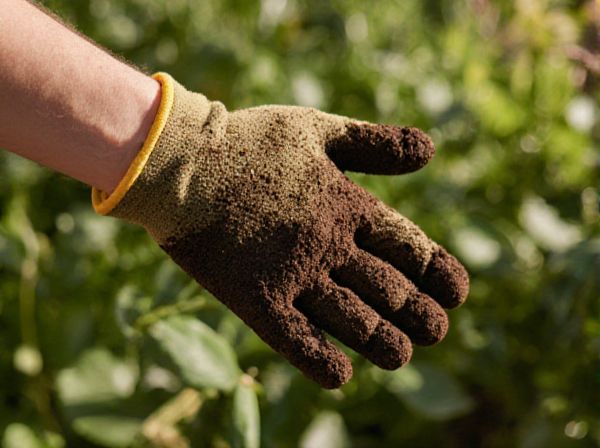
Heavy soil vs Light soil Illustration
Heavy soil, characterized by a high clay content, retains moisture and nutrients effectively but can restrict root growth and drainage. Light soil, often sandy, offers excellent drainage and aeration but requires frequent watering and nutrient replenishment due to its quick drying nature. Understanding the differences between heavy and light soil is essential for selecting appropriate plants and optimizing soil management practices.
Table of Comparison
| Feature | Heavy Soil | Light Soil |
|---|---|---|
| Texture | Clay-rich, dense, sticky | Sandy, loose, crumbly |
| Drainage | Poor drainage, water retention | Excellent drainage, dries quickly |
| Air Circulation | Low air permeability | High air permeability |
| Fertility | High nutrient content but less accessible | Lower nutrients but easier root penetration |
| Workability | Hard to till, heavy when wet | Easy to till, light and friable |
| Plant Suitability | Best for water-loving plants | Ideal for drought-tolerant plants |
| Water Holding Capacity | High | Low |
| Examples | Clay soil, silty clay | Sandy soil, loamy sand |
Understanding Heavy Soil: Composition and Characteristics
Heavy soil is primarily composed of high clay content, which results in fine particles that are tightly packed and retain moisture effectively. Its dense structure leads to slow drainage and reduced aeration, making it challenging for root penetration and microbial activity. The compact nature of heavy soil demands careful management to improve its fertility and workability for optimal plant growth.
What Defines Light Soil in Gardening?
Light soil in gardening is characterized by its sandy texture, excellent drainage, and low nutrient retention, making it ideal for plants requiring minimal root waterlogging. This type of soil warms up quickly in spring, promoting early seed germination and root development. Unlike heavy soil, which is dense and clay-rich, light soil provides superior aeration and is easier to cultivate for crops like carrots, lettuce, and radishes.
Key Differences Between Heavy and Light Soils
Heavy soil has a high clay content, resulting in poor drainage, slow water absorption, and greater nutrient retention, making it dense and compact. Light soil contains more sand, offering excellent drainage, rapid water infiltration, and lower nutrient holding capacity, leading to a loose, crumbly texture. These differences affect root penetration, moisture availability, and suitability for various crops or plants.
Pros and Cons of Heavy Soils for Plant Growth
Heavy soils, characterized by high clay content and fine particles, retain moisture and nutrients effectively, supporting sustained plant growth during dry conditions. However, their dense structure often leads to poor aeration and slow drainage, increasing the risk of root rot and limiting oxygen availability. The compact nature of heavy soils can impede root penetration and limit microbial activity, potentially reducing overall soil fertility and plant health.
Advantages of Using Light Soil in Your Garden
Light soil offers superior drainage and aeration, which encourages stronger root development and healthier plant growth. Its fine texture allows for easier cultivation and better nutrient absorption compared to heavy soil, reducing the risk of waterlogging and root rot. Gardens with light soil typically require less frequent watering and provide optimal conditions for a wide variety of plants.
Water Retention in Heavy vs Light Soils
Heavy soil, characterized by high clay content, has excellent water retention due to its fine particles and low permeability, which slows drainage and prolongs moisture availability to plants. Light soil, typically sandy, drains quickly and retains less water because of larger particle size and higher permeability, requiring more frequent irrigation to maintain adequate moisture levels. The difference in water retention significantly impacts irrigation practices and crop selection based on soil type.
Aeration and Drainage: Soil Texture Matters
Heavy soil, characterized by a high clay content, has poor aeration and slow drainage, leading to waterlogging and root oxygen deficiency. Light soil, rich in sand and silt, promotes excellent aeration and rapid drainage, preventing root rot and supporting healthy plant growth. Soil texture directly influences pore size and water movement, making it a critical factor in managing soil aeration and drainage for optimal crop productivity.
Best Plants for Heavy Soil Types
Heavy soil, characterized by high clay content and poor drainage, supports plants like hydrangeas, hostas, and daylilies that thrive in moisture-retentive conditions. These plants tolerate compacted, nutrient-rich soil and benefit from the consistent moisture heavy soils retain. For optimal growth, heavy soil conditions require plants with strong root systems capable of handling potential waterlogging and limited aeration.
Top Plant Choices for Light, Sandy Soils
Light, sandy soils drain quickly and are ideal for plants such as lavender, rosemary, and sedum, which thrive in well-aerated, nutrient-poor conditions. These soils benefit from the addition of organic matter to improve water retention and nutrient availability, supporting herbs, succulents, and certain grasses. Choosing drought-tolerant and deep-rooted species ensures healthy growth and resilience in sandy soil environments.
Improving Your Garden Soil: Tips for Balancing Heavy and Light Textures
Improving garden soil requires balancing heavy clay soils with heavy textures and sandy soils with light textures to optimize water retention and nutrient availability. Incorporate organic matter such as compost or well-rotted manure to enhance soil structure, increase aeration in heavy soils, and improve moisture retention in lighter soils. Regularly testing soil pH and texture guides amendments, ensuring optimal growth conditions for a wide range of plants.
Heavy soil vs Light soil Infographic

 gardendif.com
gardendif.com